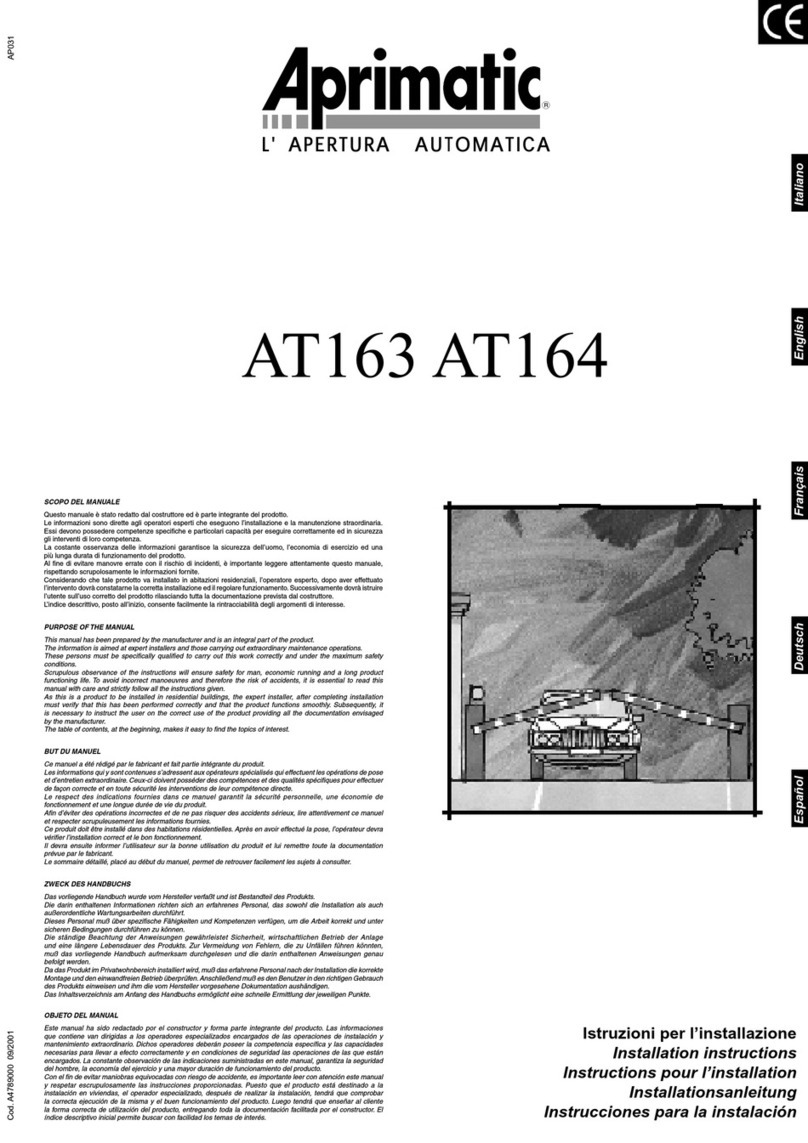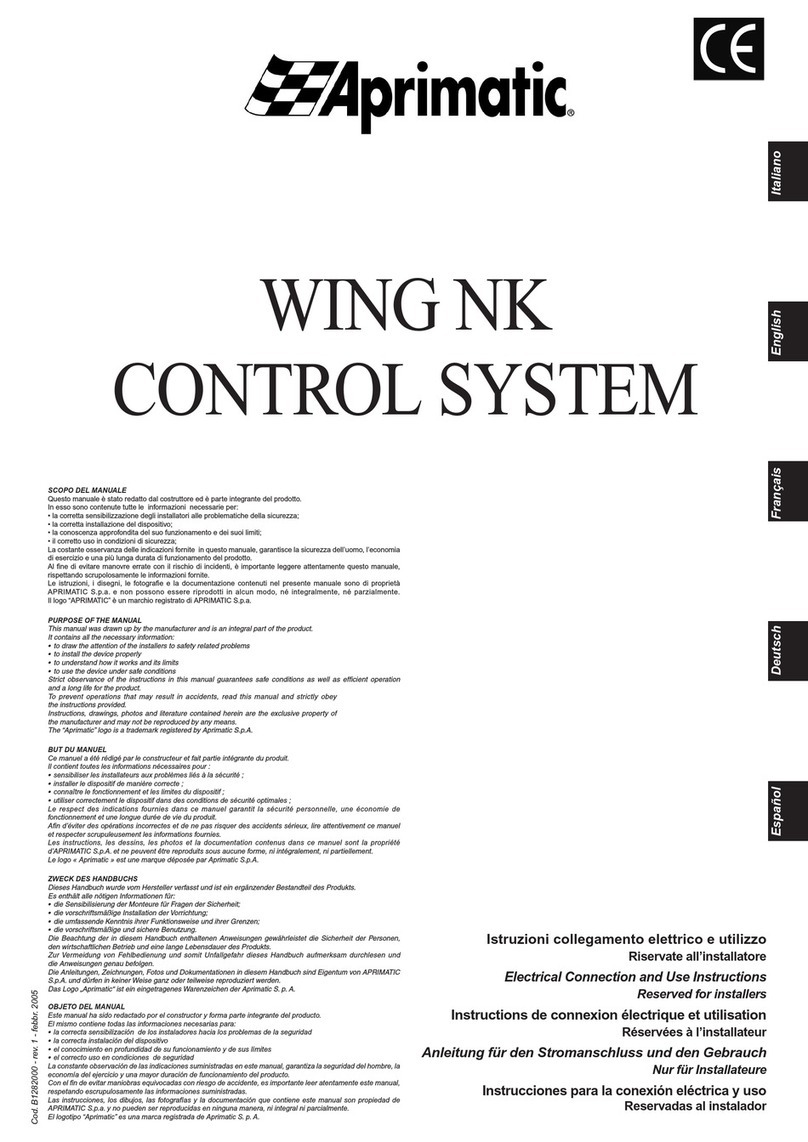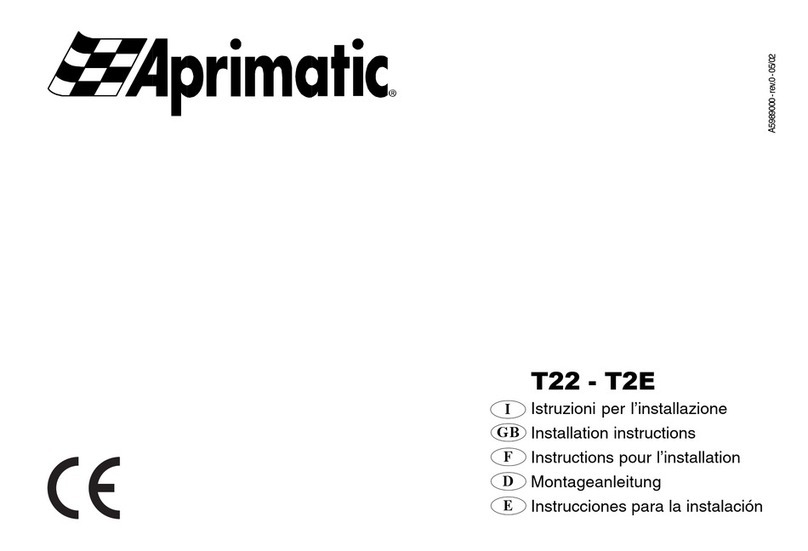
9. PROGRAMMAZIONE COMANDI RF
Per modificare l’assegnazione standard tasti - comandi RF procedere nel modo seguente:
1. Premere il tasto SW1 (tasto programmazione comandi RF) finchénon vengono emessi due beep lenti a
segnalare l’ingresso nella fase di assegnazione.
2. Premere in sequenza, su di un telecomando giàmemorizzato, i tasti corrispondenti ai comandi comandi Canale
1, Canale 2, Attivazione Centralizzata e Disattivazione Centralizzata: dopo ogni assegnazione viene emesso
un numero di beep uguale al numero di comandi giàassegnati.
Tutte le assegnazioni sono facoltative: per saltare l’assegnazione di un comando, premere il tasto SW2 (tasto
programmazione tempi) invece del tasto del telecomando.
3. Una volta eseguite tutte le assegnazioni tasto - comando, la procedura termina automaticamente (con
l’emissione di due beep lenti).
Informazioni
In caso di errore (ad es. piùcomandi assegnati allo stesso tasto), al termine della fase di assegnazione viene
emessa una serie di beep veloci come segnalazione: automaticamente èpossibile ripetere l’assegnazione dei
tasti a partire da quello assegnato al comando “Canale 1”.
Se, una volta entrati nella fase di assegnazione, trascorrono piùdi 15 secondi senza che venga assegnato alcun
tasto, la procedura termina automaticamente (time-out); restano valide le programmazioni precedenti.
In caso di errore, per uscire dalla procedura, èsufficiente non premere alcun tasto (vedi punto precedente)
oppure premere il tasto SW1 (tasto programmazione comandi RF): anche in questo caso restano valide
le programmazioni precedenti.
Nel caso si vogliano modificare le assegnazioni successivamente all’installazione del modulo e qualora esso non
sia facilmente accessibile, èpossibile eseguire la procedura totalmente via radio.
a - Premere contemporaneamente i tasti 1-4-5-8 nel caso di un TR14 oppure tutti i tasti nel caso di un TR2 o di
un TR4, fino a che l’apparecchiatura non genera un beep veloce, quindi rilasciare i tasti
b - entro 5 secondi, ripetere l’operazione mantenendo i tasti premuti finchénon vengono emessi due beep veloci
e quindi due beep lenti ad indicare che la fase di apprendimento èin corso.
Procedere poi con le modalitàgiàdescritte, tenendo presente che per saltare l’assegnazione di un tasto ad
un comando ènecessario di nuovo premere contemporaneamente i tasti 1-4-5-8 nel caso di un TR14 oppure
tutti i tasti nel caso di un TR2 o di un TR4.
10. PROGRAMMAZIONE DEI TEMPI
In configurazione standard i tempi di timer per i canali 1 e 2 sono uguali e pari a 45 secondi o 45 minuti a secondo
della logica prescelta (vedi par.8). Nel caso si renda necessario variarli, procedere nel modo seguente:
1. Premere il tasto SW2 (tasto programmazione tempi) finchénon vengono emessi tre beep lenti a segnalare
l’ingresso nella fase di programmazione.
2. Premere il pulsante o il tasto del telecomando relativo al comando di “Canale 1”: automaticamente parte il
conteggio del tempo, segnalato dall’emissione di un beep ogni secondo trascorso.
3. Contare il numero di impulsi emessi dal beep e, una volta raggiunto il numero voluto per il tempo di timer
per il canale 1 (equivalente al numero di secondi o di minuti del tempo di attivazione desiderato), ripremere il
medesimo pulsante o tasto del telecomando: il conteggio si ferma e l’impostazione eseguita viene memorizzata
dall’apparecchiatura che emette due brevi beep per segnalare l’avvenuta memorizzazione.
4. Ripetere i passi 2 e 3 per la programmazione del tempo di timer per il canale 2.
5. Una volta eseguite entrambe le programmazioni la procedura termina automaticamente (con l’emissione
di tre beep lenti).
Informazioni
Se, una volta entrati nella fase di programmazione, trascorrono piùdi 15 secondi senza che venga eseguita
alcuna operazione la procedura termina automaticamente (time-out): restano valide le programmazioni
precedenti.
In caso di errore, per uscire dalla procedura, èsufficiente non eseguire alcuna operazione oppure premere
il tasto SW2 (tasto programmazione tempi): anche in questo caso restano valide le programmazioni
precedenti.
Nel caso si vogliano modificare le assegnazioni successivamente all’installazione del modulo, se l’accesso
ai tasti posti sull’apparecchiatura risulta non agevole, èpossibile eseguire la procedura precedentemente
illustrata, totalmente via radio.
a - Premere contemporaneamente i tasti 1-4-5-8 nel caso di un TR14 oppure tutti i tasti nel caso di un TR2 o di un
TR4, fino a che l’apparecchiatura non genera un beep, quindi rilasciare velocemente i tasti;
b - entro 5 secondi, ripetere l’operazione finchénon vengono emessi due beep, quindi rilasciare velocemente
i tasti;
c - nuovamente, entro 5 secondi, ripetere l’operazione mantenendo i tasti premuti finchénon vengono emessi tre
beep veloci e tre beep lenti ad indicare che la fase di programmazione èin corso.
Procedere poi con le modalitàgiàdescritte.































